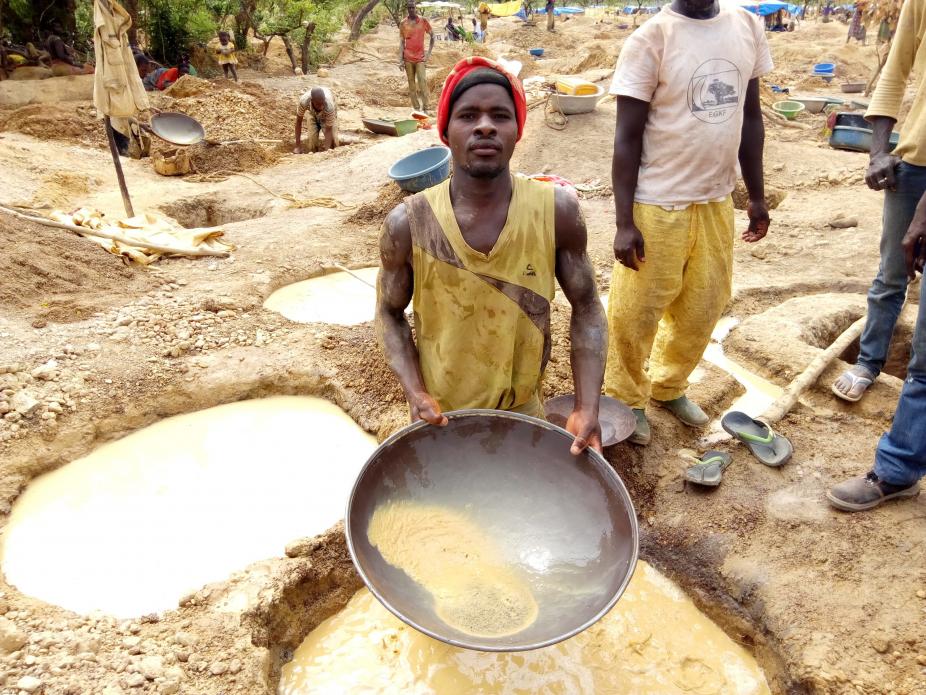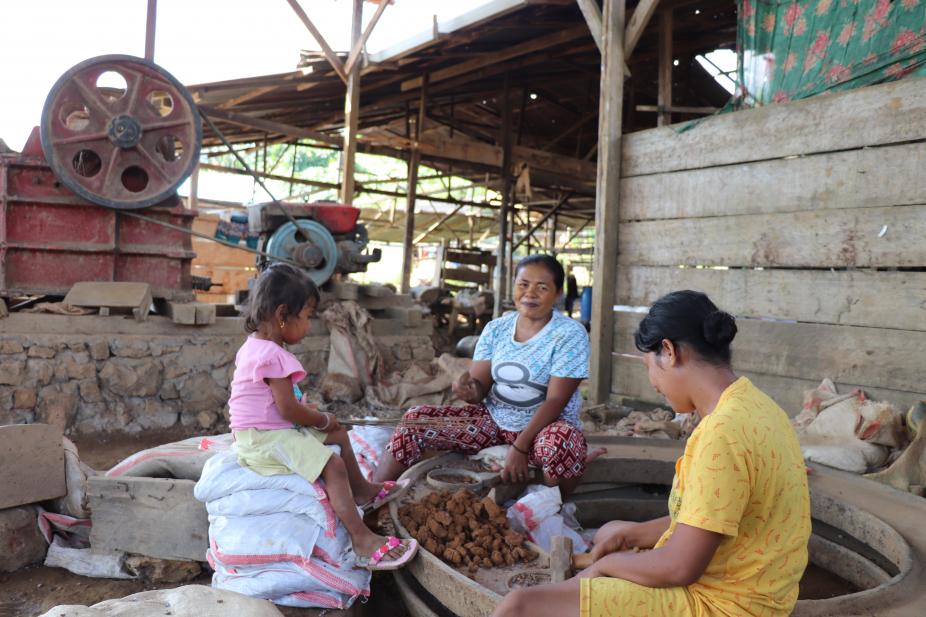A gold mine of information: lessons from early GEF efforts to reduce mercury in artisanal and small-scale gold mining
By Gabriel Sidman, Evaluation Officer, Global Environment Facility Independent Evaluation Office

Photo credit: Gold panner in Burkina Faso, where the GEF has a long history of working in the artisanal and small-scale gold mining sector. Ⓒ Artisanal Gold Council.PlanetGold.org
It was the early 2010s: excitement was growing for the idea of a new international convention to combat mercury emissions. The Global Environment Facility (GEF), a critical source of funding for many international conventions, was considering how to prepare the new convention’s eventual creation. The stakes were high—GEF needed to show that it was a capable financial mechanism for the future convention even though up until then, its chemicals programs were designed to tackle entirely different substances regulated by the Stockholm Convention. It also aimed to prove that development projects could create sustainable reductions in mercury use in major emitting sectors. GEF decided to invest in a sector that offered both challenge and potential reward: artisanal and small-scale gold mining (ASGM), a sector that is disperse, largely unregulated and also considered the largest emitter of mercury in the world.
In 2012, GEF began pilot projects in three diverse landscapes—Burkina Faso and Senegal, Ecuador and Peru and the Philippines. Each project aimed to test how well the GEF could introduce and promote take up of non-mercury gold processing equipment in mining communities, leading to reductions in mercury use. By the time these projects finished in 2017, the global mercury reduction policy picture had changed: the Minamata Convention was coming into force and GEF was part of the financial mechanism, making mercury reduction a key part of GEF’s strategy to the present day. Now, GEF is investing in the Global Opportunities for Long-term Development of the ASGM Sector (GOLD) and GOLD+ programs (which together form the planetGOLD initiative), multi-million-dollar investments that are the flagship for the global fight against mercury emissions in ASGM. But as these two programs move forward in new and innovative ways, it is also important to look back at the older projects. What is the situation today in the mining communities these GEF projects worked in for several years, but then left? Was mercury use really reduced sustainably in the communities? What lessons can be learned from these early efforts and are they reflected in GEF’s planetGOLD programs? Answering these questions, which can show how well GEF has grown and adapted its strategy towards reducing mercury use in ASGM overtime, was a key component of the GEF Independent Evaluation’s (GEF IEO) evaluation of the GEF interventions in the ASGM sector. Here, we take a look at what this post-completion evaluation uncovered.
Reducing mercury use: success paired with unintended consequences
All of the pilot projects had some success in reducing mercury use in the communities in which they worked. The largest decrease in mercury use was seen in Portovelo, Ecuador, a large mountain town that processes gold mined all over the country. Because of the large volume of ore processed in the town and the relative wealth of the owners of the processing equipment, community members were more willing to invest in new methods. In the Philippines, reductions in mercury use were seen in all communities the project worked at, followed up by health testing that showed blood mercury levels decreased in miners from the beginning to the end of the project. In Burkina Faso and Senegal, non-mercury processing plants were installed and were being used at project end.
Looking at mercury use in these communities today, at first glance, the GEF projects appear to have had great success—many mercury reductions were sustainable. Portovelo continues to use much less mercury than the era before the pilot project. In Diwalwal, Philippines, continued enforcement by the government means mercury has not made a comeback there, either. However, success was not universal. Other areas of the Philippines were not as well-enforced by the government and didn’t see any further reductions in mercury use post-project. In Burkina Faso, some parts of the installed machinery have broken and community members have neither the correct parts nor the expertise to repair. Furthermore, in some locations, especially Portovelo, the method used to replace mercury, cyanidation, is less than ideal. The cyanide used in this alternate process is also a poison and if not properly handled and disposed of, has human and ecosystem health implications. Studies have shown such contamination to be a problem downstream of Portovelo. Cyanidation was not promoted by GEF projects—but is a readily available alternative to miners around the world, and thus is widely used.

Photo credit: Women crushing ore on Obi Island, South Halmahera Province, Indonesia. Indonesia is one of the eight countries involved in the GEF’s Global Opportunities for Long-term Development of the ASGM Sector (GOLD) program. Ⓒ UNDP Indonesia. PlanetGold.org
Miner formalization: early support reaps rewards
Beyond mercury reductions, the pilot projects hoped to catalyze miner formalization, by which miners were officially recognized and registered by their governments. Formalization means better regulation of miners, control of workplace conditions and trade of hazardous materials (such as mercury). It also allows miners better access to financing, a key element to facilitating the purchase of non-mercury processing equipment, which can be an expensive upfront investment. However, the projects had little success in formalization during implementation—in Philippines, a national association of small-scale miners was established, but limited miners joined during the project. In northern Peru, some miners were helped to begin the formalization process, but none achieved full formalization by the project’s end.
However, years after completion, it is clear that the projects catalyzed formalization efforts. The Philippines association of small-scale miners has continued to grow in number of miners and in its influence on policy. Peruvian miners involved in the project have since reached full formalization and many others in their community have achieved it as well. Additionally, all the countries involved in these pilot projects have gone on to ratify the Minamata Convention, mainstreaming mercury reduction and miner formalization processes into policy, showing the lasting influence of early GEF support.
A golden opportunity to learn: planetGOLD adjusts GEF’s strategy
The large planetGOLD programs today share some characteristics with their predecessors: all child projects in the GOLD program heavily feature introduction to non-mercury technologies in some of the same places—of the original five countries involved in pilot projects, only Senegal isn’t involved in the GOLD program. But the programs break with past efforts too: they go beyond a simple focus on technology introduction and limited efforts on formalization. One lesson from the pilots was that miners not only lacked the capital to invest in non-mercury technologies, but they had trouble accessing traditional lending opportunities. Banks were afraid to lend to an unregulated sector which they didn’t understand and lacked traditional forms of collateral (many miners don’t own the land they mine on). The response of the GOLD program was to focus heavily on access to financing, not only continuing miner formalization but also educating lenders and creating new financial mechanisms specifically for miners. Additionally, planetGOLD has ramped up its collaboration and knowledge management efforts, giving opportunities for projects in neighboring countries to share experiences and trade advice, promoting a level of learning that wasn’t present in the early pilots.
This post-completion evaluation of GEF’s early efforts shed light on successes and consequences of the actions of those early projects that weren’t clear during or even shortly after their completion. In some cases, good intentions can lead to unforeseen future problems. In others, a less than ideal result during implementation is seen as a successful catalyst in the long term. In all cases, the key is to remember the past when improving for the future.



